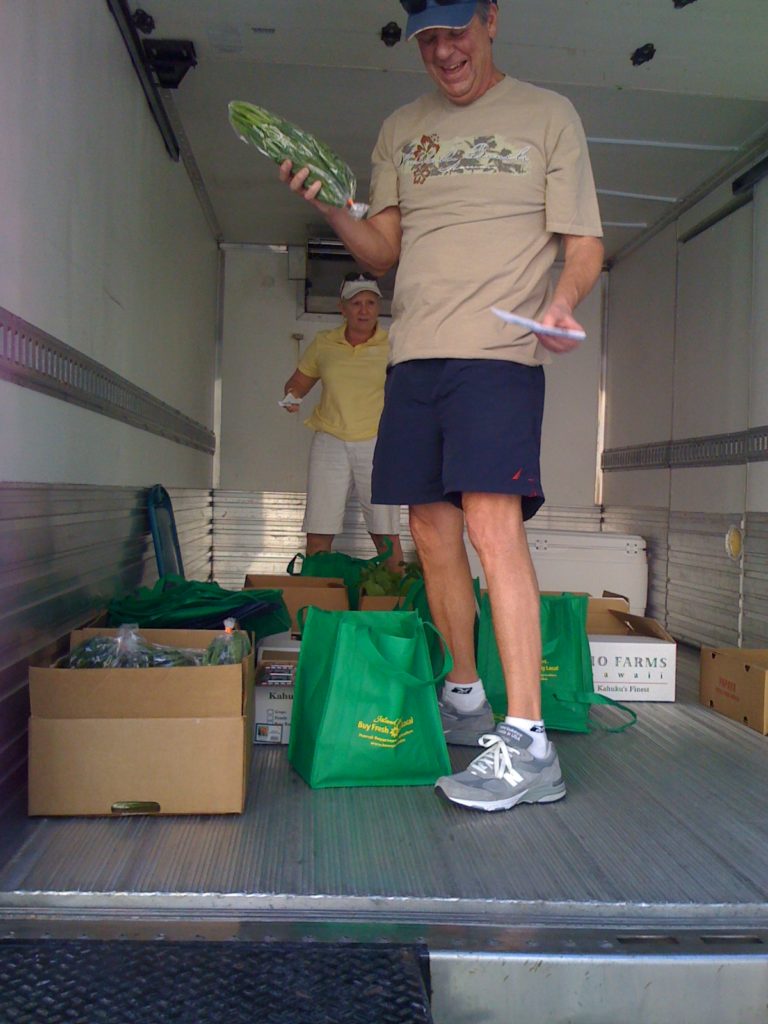Whats wrong with this picture??
Organic Bag Survey
We are thinking about putting together a 100% organic bag. Please help us by filling out the survey below
O`ahu Fresh Special Guests Gary & Margo Make A Delivery Appearance
O`ahu Fresh had its first group of special guests join us on the fresh, local delivery road. They came to Hawaii for a nice, relaxing vacation, little did they know they would be knee deep in Japanese cucumbers and Thai Basil, driving all over Honolulu in a 16 foot refrigerator truck, and bringing bags of fresh, local produce to offices in Honolulu!

The demand is there for locally grown food
By Cynthia Oi
POSTED: 01:30 a.m. HST, Jan 03, 2010
(Single Page View) | Return to Paginated View
The thought that Hawaii could produce enough food to feed its human inhabitants comes up from time to time. It is usually dismissed as a fanciful idea of sentimentalists wanting to return to a Utopian island existence that never really was.
Now comes a study suggesting that early Hawaiian agriculture was vast and substantially more complex than previously known, implying that what was grown fed a population of perhaps a million people, which is about the present occupancy of Hawaii.
Samuel M. Gon III was clearly excited by the findings of a team of researchers and scientists from noted institutions.
“If a million mouths could be fed back then, this points to a future where we can wean our reliance on food from the outside world,” said Gon, who as senior scientist with The Nature Conservancy in Hawaii participated in the study.
I admire Gon’s vision, but I doubt that many of Hawaii’s political, business, corporate and investment leaders would accept his assessment. Neither would many who claim to represent agriculture and farming interests here.
Hawaii is too far gone in its obligations to use its land and water for other purposes. Those natural resources produce far more dollars when consumed for roofs and walls and for quenching a thirst for revenue streams fed by an ever-increasing number of people, both transient and permanent.
To change direction would be like trying to divert a rail car by heaping taro on a $5 billion track. And with food tastes the way they are, with hamburgers and fries as typical sustenance rather than poi and sweet potatoes, growing everything we want to eat would be impossible.
Still, we can cultivate a lot of what goes into our meals.
A look at the dozens of farmers markets that have sprung up on every island in the past few years—proof of the desire of local consumers for local foods—shows the wealth of fruits, veggies, meat, eggs and dairy products that originate in native soil.
Speckled oranges from trees in Kau, considered unconventional two decades ago, are now common in grocery stores. Local lemons also look different, but their flavor and juice are far better than that of the yellow, thick-pith varieties from California, Florida or Mexico.
Strawberries from Kula or Waimea take the shortcake to higher taste levels, and, if experimental crops turn out well, blueberries and other summer berries from Hawaii island and Maui will soon be on our tables year-round.
Less fancy stuff, like bok choy, onions, peppers, potatoes and leafy greens are already familiar, locally grown plate-lunch ingredients. With planning and incentives, those could be part of school lunches as well.
Maybe we can’t grow staples like rice, wheat and cattle in financially practical quantities. But there are thousands of empty acres, all suitable for one kind of crop or another.
If farmers had the infrastructure they needed—dependable water supply, long-term land leases, reasonably priced, reliable transportation and distribution networks—Hawaii could become less dependent on California, Florida and Mexico for food.
The possibilities are limited only by lack of will.
Cynthia Oi can be reached at coi@starbulletin.com.
